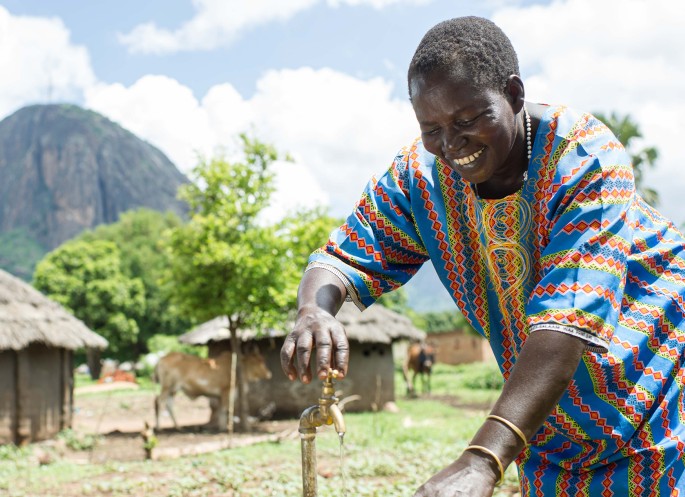A big elephant in the room: Africa’s Water Sector Investment Costs
During the 9th World Water Forum held in Dakar, Senegal, last week, investments in the water sector to enhance Human Rights to Water and Sanitation (HRWS) were amplified in different panel sessions. The Africa Water Investment Programme (AIP), which is part of Programme for Infrastructure Development in Africa (PIDA), was amongst the most vocal ones about this.
Simavi advocates Rashidah Kulanyi (Uganda) and Patrick Mwanzia (Kenya) attended the World Water Forum on behalf of Simavi. To co-create a movement and momentum for grassroots-driven water solutions. To mobilise fellow water activists towards the UN Climate Summit and UN Water Conference.
Delivery of water investments across Africa is below target
According to AIP – PIDA, “delivery of water investments across Africa is below target to meet the continent’s growing water needs”. During the International High – Level Panel on Water Investments for Africa Session during the 9th WWF in Dakar City, figures were laid bare concerning the under investment in the sector. “The current water and sanitation sector investment in Africa stands at between USD 10 – 19 billion/year’’ stated AIP – PIDA.
Globally, no sector can be unilaterally developed without giving reference to water. Water links natural, economic and social systems on earth. Given the climate crisis, increasing global population levels, growing economies and poor water governance challenges across the globe, these exert pressure on the meagre world fresh water resources.
Policy makers need to put their money where their mouth is
“African Development Bank (ADB) estimates indicate that, USD 64 billion/year needs to be invested in water security to meet the Africa Water Vision 2025 and SDG targets”, urges AIP – PIDA. This implies that, there is water investment gap of between USD 45 – 54 billion/year. This is a serious threat to the progressive realization of HRWS in Africa. However, AIP – PIDA aims to narrow the investment gap by mobilising a target of USD 30 billion/year by 2030, in an attempt to salvage the precarious situation. If we want to make the human rights to water and sanitation real, policy makers need to put their money where their mouth is. Therefore, Simavi advocates together with the previously mentioned organisations, for increased investments in community-driven water solutions.
Anchor the human rights to water and sanitation in national legislations
Governments have the obligation to respect, protect and fulfil Human Rights to Water and Sanitation (HRWS) as spelt out in Sustainable Development Goal 6 targets 1 and 2. For instance, Kenya’s basic human rights to water and sanitation services are anchored in the Constitution of Kenya 2010, Article 43. Given this solid legal framework, the government is constitutionally obliged to respect, protect and progressively fulfill these rights in collaboration with other sector stakeholders. Simavi advocates with African governments to follow Kenya’s example, and anchor the human rights to water and sanitation in national legislations.
By respect it means States refrain from interfering directly or indirectly with the enjoyment of the rights to water and sanitation; protect implies States prevent third parties from interfering in any way with the enjoyment of the human rights to water and sanitation and fulfillment means States adopt the necessary measures directed towards the full realization of the human rights to water and sanitation.
Mutual accountability and peer reviews
During the 9th WWF in Dakar, AIP – PIDA announced that in February 2022, a scorecard for tracking progress made by countries in increasing water investments had been developed and ready for use. It will promote “mutual accountability, peer reviews at continental, regional, national, sub -national an community levels”
One of the key measures governments need to make is increasing significant investments/funding in the water sector with public resources (for resources protection and services provision). Another key measure is to create an enabling environment for civil societies and private sector to invest in the water sector to promote fulfilment of HRWS. And last but not least, they have to make sure that water and sanitation services are climate-resilient, now and in the future.
What needs to be done
If the water investment gap is not fully resolved in the short run, the worst case scenario is that African countries will miss hitting the SGD 6 targets by 2030. This is a bad prospect, and breaking with business-as-usual approaches are required to avoid this from happening. This starts with political good will among the heads of state and governments. It further implies, we need not only aim at increased national budget allocations in the water sector, but also at accountability in the budgets expenditures in the sector – a role that civil society needs to take lead on together with local citizens. And last but not least, It is crucial that states and governments recognize the grassroots solutions and perspectives of local communities. Female community leaders are not only at the forefront of the water crisis, but they are also the ones leading by example. Simavi says: they need to be in the drivers seat!


